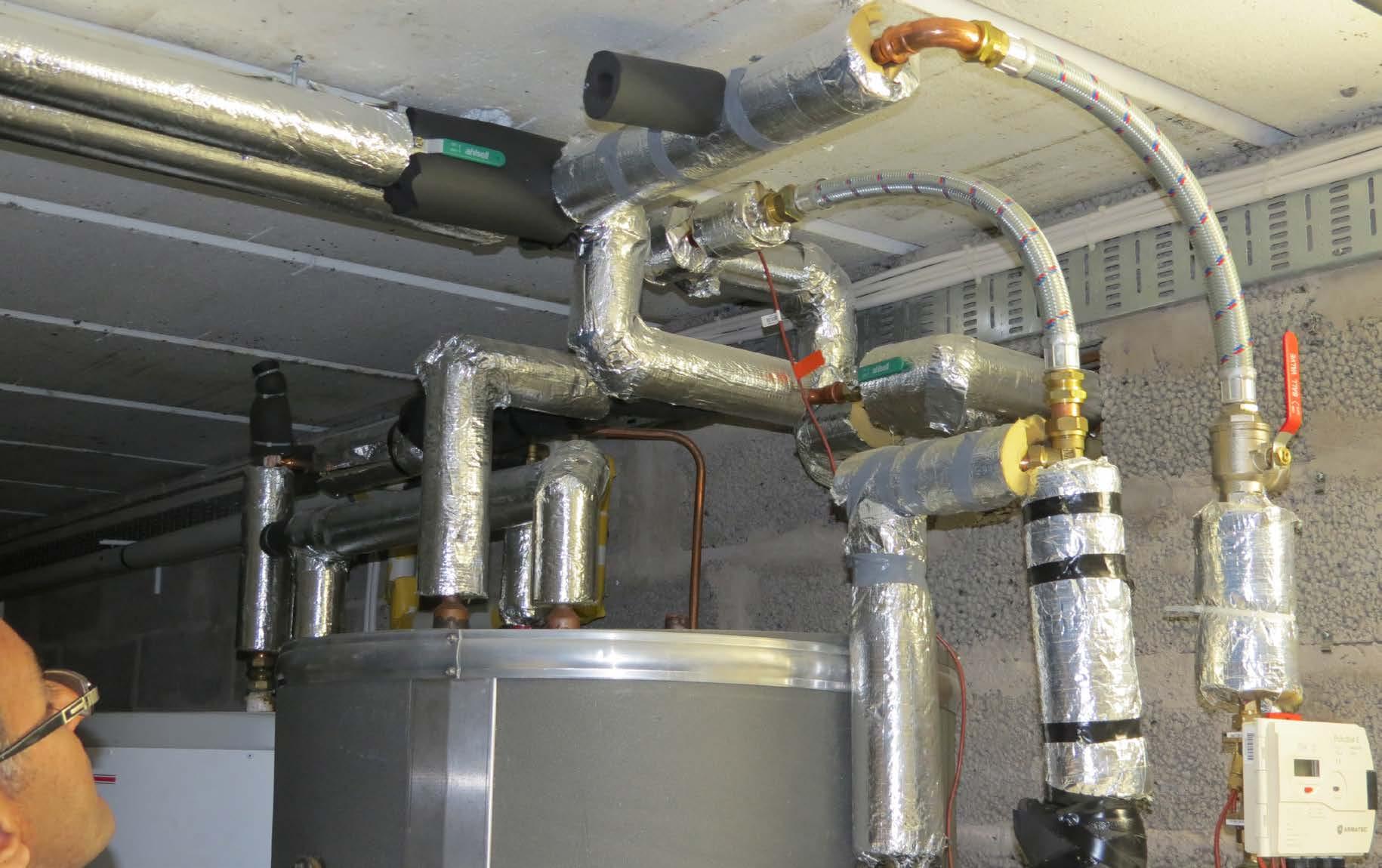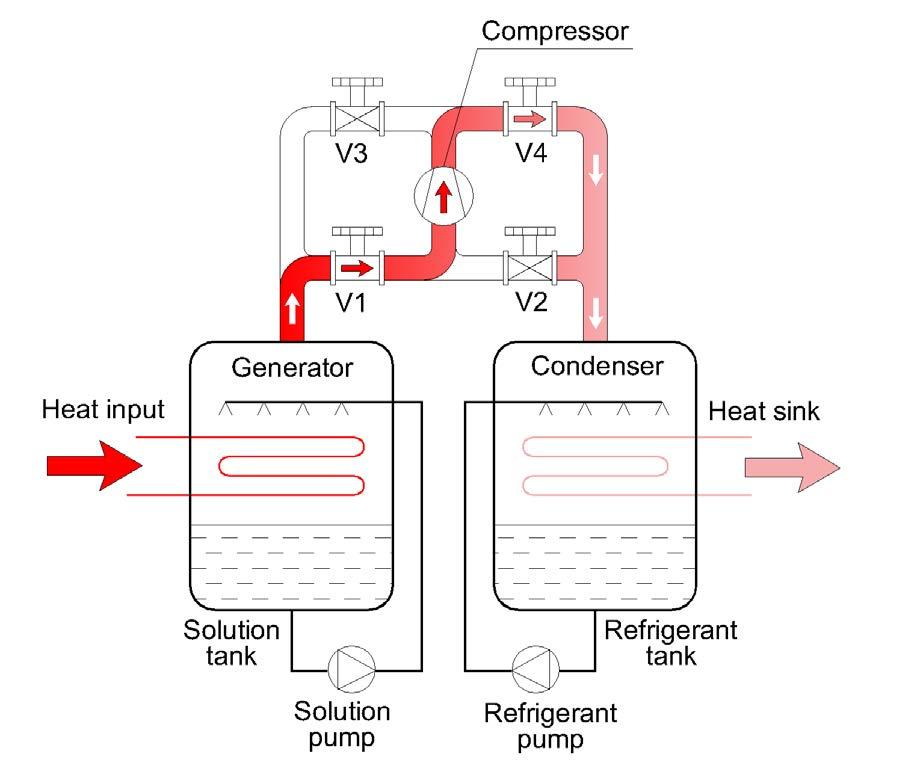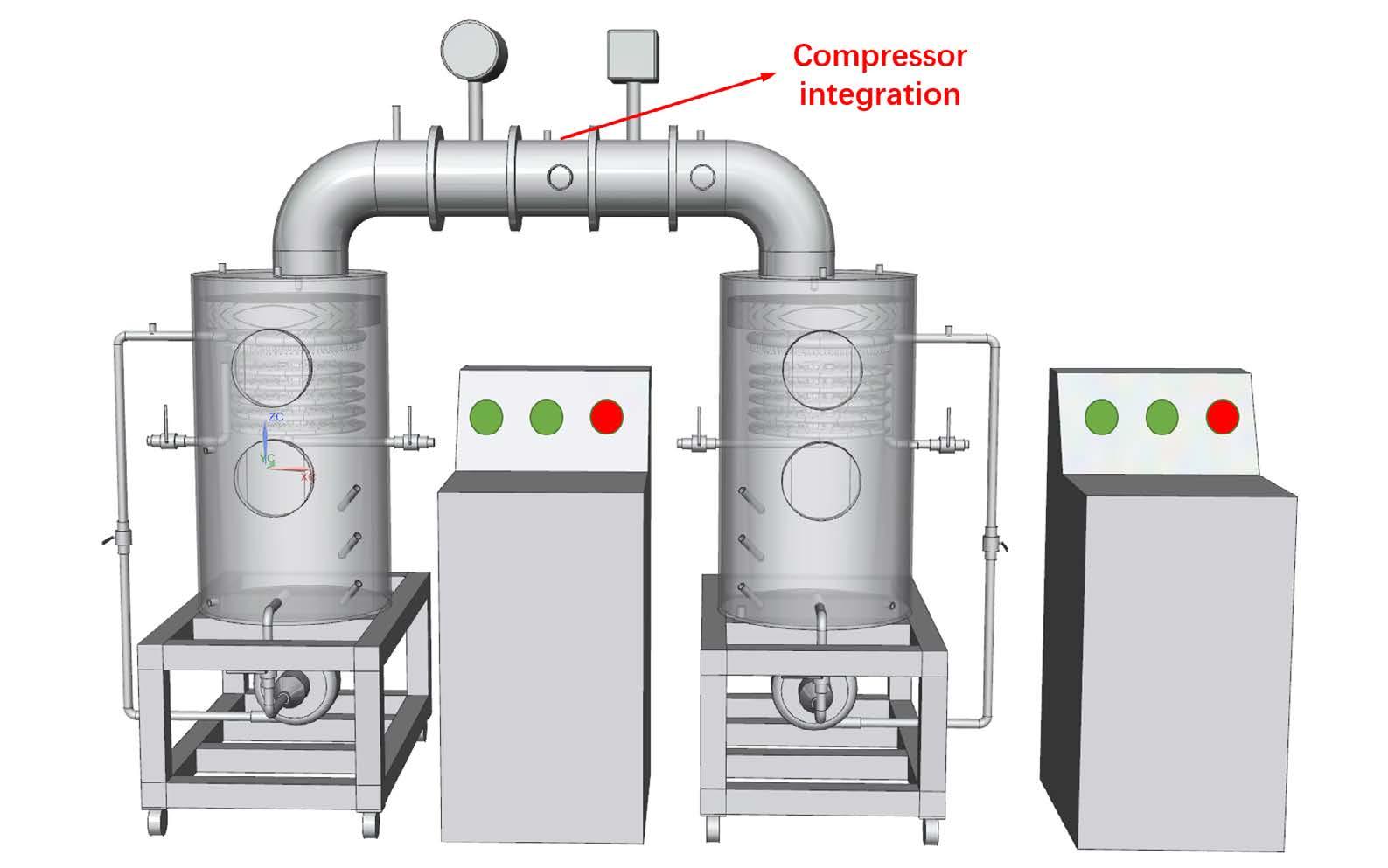
12 minute read
Ongoing Annexes in HPT TCP
from HPT Magazine Vol.38 No 3/2020 - Digitalization as an enabler for a robust, flexible and ...
by HPT Magazine
The projects within the HPT TCP are known as Annexes. Participation in an Annex is an efficient way of increasing national knowledge, both regarding the specific project objective, but also by international information exchange. Annexes operate for a limited period of time, and the objectives may vary from research to implementation of new technology.
INDUSTRIAL HEAT PUMPS, SECOND PHASE
DESIGN AND INTEGRATION OF HEAT PUMPS FOR nZEB
HEAT PUMPS IN MULTI-FAMILY BUILDINGS FOR SPACE HEATING AND DHW
ACOUSTIC SIGNATURE OF HEAT PUMPS
HEAT PUMP SYSTEMS WITH LOW GWP REFRIGERANTS
COMFORT AND CLIMATE BOX
INTERNET OF THINGS FOR HEAT PUMPS
48 49 50 51 52 53 54 55 56
AT, CH, DE*, DK, FR, JP, UK
AT, BE, CH, DE, NO, SE, UK, US
AT, CH, DE, FR, IT, NL
AT, DE, DK, FR, IT, SE
DE , FI, IT, NL, NO, SE, UK, US
CN, DE, IT, KR, SE, US
AT, DE, FR, IT, JP, KR, SE, US
AT, CA, DE, FR, IT, NL, SE, UK, US
AT, FR, DE, NO, CH
NEW *) Operating Agent from Germany, but no other parties from the country participate.
The Technology Collaboration Programme on Heat Pumping Technologies participating countries are: Austria (AT), Belgium (BE), Canada (CA), China (CN), Denmark (DK), Finland (FI), France (FR), Germany (DE), Italy (IT), Japan (JP), the Netherlands (NL), Norway (NO), South Korea (KR), Sweden (SE), Switzerland (CH), the United Kingdom (UK), and the United States (US).
Bold, red text indicates Operating Agent (Project Leader).
ANNEX ANNEX 46 51
ACOUSTIC SIGNATURE OF HEAT PUMPS
Introduction
To further increase the acceptance of heat pumps, reduction of acoustic emissions is important. To minimize noise annoyance, more focus must be put on the acoustic emissions at steady state and on the transient behaviour of acoustic signatures during different operating conditions. Placement of the heat pumps is also of utmost importance, as sound emissions exhibit a pronounced directivity. Especially, air to water heat pumps provide a convenient and effective way to exploit potential energy savings and are often used in retrofit installations, making acoustic improvements crucial due to their noise producing components like compressors and fans.
During the course of the HPT Annex 51, members have convened at CETIAT (France), RISE (Sweden), DTI (Denmark) and ISE (Germany), followed by two online meetings with the last one on September 9, 2020. This was the final meeting which focused primarily on the publication of the promised deliverables, which will be available to download by the end of 2020 on the IEA HPT Annex 51 website.
Psychoacoustic tests have been carried out by the Acoustic Research Institute of the Austrian Academy of Sciences. These will give input to the test design used in Annex 51. A joint acoustic data set is currently being analysed using psychoacoustic hearing tests. The interesting results will be summarised in a document which will also be available for free download.
A concluding webinar, guiding through the results of IEA HPT Annex 51, is planned to take place on November 30, 2020.
Objectives
» Increase the acceptance of heat pumps for comfort purpose with respect to the noise and vibration emissions; » Increase knowledge and expertise at different levels; » Provide input to national and international standardization; » Preparation of seven Annex meetings; five meetings held (Austria Vienna 06-2017, France Lyon 01-2018, Sweden Borås, 06-2018, Denmark Aarhus, 01-2019, Germany Freiburg 10-2019), two online meetings (Internet, 03-2020 and 09-2020); » Workshop on acoustics of heat pumps at the ICR2019 in Montreal held; presentation published on the IEA HPT Annex 51 website; » Hold a concluding international webinar as a guide through the documents available at the IEA HPT Annex 51 website on Monday, November 30, 2020; » Worldwide dissemination to heat pump manufacturers; » Generation and distribution of Acoustic Guidelines for the different levels (Component, Unit & Application Level).
Fig. 1: COP as a result of the variation of evaporator fan speed while providing constant condenser heating capacity (outside air temperature 7 °C, heating water temperature 50 °C ). [Source: RWTH Aachen, Germany]
Results
Simultaneous assessment of energetic and acoustic heat pump performance
Heat pumps are a key technology in the energy system transformation process in order to decarbonize the heat supply of the building stock. In addition to the energy and ecologic parameters, the acoustic properties are of importance since they are a crucial measure of comfort. Operating air-to-water-heat pumps requires a compressor and a fan. Due to their rotation, both have sound emissions that can be disturbing. Thus, it is necessary to develop both energy efficient and quiet heat pumps.
The following objectives have already been reached: the development of a dynamic simulation model for the acoustic evaluation of heat pumps, coupling of the acoustic and the energetic model, the parameterisation of the acoustic model to measurement data, and the reduction of acoustic emissions of heat pumps by optimising their operation.
The operation of heat pumps can be optimized regarding both energetic performance and acoustic emissions. Hence, we developed a simulation model that simultaneously determines both the thermodynamic performance of the refrigerant circuit and its acoustic emissions. The interface between the energetic and the acoustic model is the rotational speed of the compressor
INFORMATION
Become a subscriber
The Heat Pumping Technologies Magazine
Three times a year, the Heat Pump Centre issues the Heat Pumping Technologies Magazine. The Magazine can be found at the HPT web site and is free of charge. At the same time as the Magazine is launched, a Newsletter is distributed. The Newsletter contains shorter versions of the Magazine articles with links to the full Magazine and is a good reminder that there is a new Magazine issue to read.
and of the evaporator fan. Figure 1 shows this relationship for a normalized fan speed. At constant condenser heating capacity the evaporator fan speed is varied. The study concludes that the COP-optimal operating point does not coincide with the acoustically optimal operating point. This leads to a conflict of objectives between acoustically optimal and energetically optimal evaporator fan speeds. However, figure 1 also shows a pareto effect between energetic efficiency and of acoustic emission: by comparatively small deviations from the energetic optimum, the sound emissions can be reduced significantly. Details have been submitted to the HPC2021 conference .
Annex website
https://heatpumpingtechnologies.org/annex51/
Contact
Operating Agent is Christoph Reichl, AIT Austrian Institute of Technology GmbH, Austria.
christoph.reichl@ait.ac.at
Read our Magazine and become a subscriber at:
HPTIEA Market report: Japan p. 23 Heat pumps in district heating and cooling systems p. 27 Grid flexible control of heat pumps p. 31
Heat Pumping Technologies MAGAZINE
A HEAT PUMP CENTRE PRODUCT
Integration of Heat Pumps into the Future Energy System

Svend Pedersen, OA Annex 47

”HEAT PUMPS PHASE OUT FOSSIL FUELS FROM THE ENERGY SYSTEM”
VOL.38 NO 1/2020
ISSN 2002-018X
https://heatpumpingtechnologies.org/the-magazine/
ANNEX 52
LONG-TERM MEASUREMENTS OF GSHP SYSTEMS PERFORMANCE IN COMMERCIAL, INSTITUTIONAL AND MULTI-FAMILY BUILDINGS
Introduction
With one year left to complete HPT Annex 52 the seven participating countries are compiling the results from the 40 case studies of long-term monitored GSHP systems into individual case study reports. The GSHP systems are all serving commercial, institutional or multi-family buildings with heating and/or cooling systems of varying degrees of complexity.
The outcomes from this annex will help building owners, designers and technicians to evaluate, compare and optimize GSHP systems. It will also provide useful guidance to manufacturers of instrumentation and GSHP system components, and developers of tools for monitoring, controlling and fault detection/diagnosis. This will lead to energy and cost savings.
To date, outcomes of the annex include a bibliography with published long-term performance analyses of larger GSHP systems and five published journal papers, of which open source measurement data are available for two of the published case studies. Four conference papers have so far been published; however, several more conference papers are written but not yet published as their congresses have been postponed till 2021 due to the corona virus pandemic.
Objectives
» Survey and create a library of quality long-term measurements of GSHP system performance for commercial, institutional and multi-family buildings. All types of ground sources (rock, soil, groundwater, surface water) are included in the scope. » Refine and extend current methodology to better characterize GSHP system performance serving commercial, institutional and multi-family buildings with the full range of features shown on the market, and to provide a set of benchmarks for comparisons of such GSHP systems around the world. » Compile guidelines documents for instrumentation, data collection, analysis and reporting of key performance indicators for large GSHP systems.
Recent progress
Two of the annex deliverables are nearing completion – a guide to instrumentation used to measure performance and a guide to uncertainty analysis. The instrumentation guidelines cover measurement of fundamental variables: temperature, flow, electrical power and energy. Measurement of heat transfer rates and energy using heat meters is covered, as well as measurements of the heat pump performance using refrigeration cycle measurements. Measurement of downhole temperature using optical fiber is also treated. The uncertainty analysis guidelines cover propagation of errors from the measurement of fundamental
Fig. 1: Frölunda club house, the subject of one of the case studies. Photo: J. D. Spitler.

Fig. 2: Frölunda club house, detail of the heating system. Photo: J. D. Spitler.

variables to the final estimation of performance factors and other key performance indicators such as system efficiency index. A current focus for both guides is treatment of errors that come from sources other than the sensors – e.g. sensor placement.
A recent journal paper (Liu et al. 2020), analyzing three years of detailed performance data from a club house in southwest Sweden, is part of the Annex 52 work. Several conference papers describing Annex 52 results and case studies have had their publication delayed until 2021 due to the pandemic.
INFORMATION
Annex website
http://heatpumpingtechnologies.org/annex52/
Contact
Operating Agent is Signhild Gehlin, Swedish Centre for Shallow Geothermal Energy in Sweden. signhild@geoenergicentrum.se
Always visit our website for news, the latest updates and more information: heatpumpingtechnologies.org

53
ADVANCED COOLING/ REFRIGERATION TECHNOLOGIES DEVELOPMENT
Introduction
Air conditioning (AC) and refrigeration systems are responsible for a large share of worldwide energy consumption today, while demand is expected to increase sharply in the next 50 years, if no corrective actions are taken. IEA projects that AC energy use by 2050 will increase 4.5 times over 2013 levels for non-OECD countries and 1.3 times for OECD countries. Worldwide action, both near-term (e.g., increased deployment of current “best” technologies) and longer-term (RD&D to develop advanced solutions), is urgently needed to address this challenge. Annex 53 focuses on the longer-term RD&D need. Technologies of interest include vapor compression (VC) and non-traditional cooling approaches, including alternative advanced VC and thermal compression (TC) cycles.
The technical scope of Annex 53 is very broad by design. It is not likely that there will be only one, or even a few, “right” solutions to the challenge.
Objectives
Annex 53’s main objective is longer term R&D and information sharing to push development of higher efficiency and reduced greenhouse gas (GHG) emission AC/refrigeration-focused HP technologies. Specific areas of investigation include, but are not limited to, the following: » Advance the technology readiness level (TRL) of non-traditional and alternative VC technologies to bring them closer to the market; » Independent control of latent and sensible cooling and tailoring systems for different climates (e.g. hot dry or hot humid); » Advances to VC-based technologies, both conventional and non-traditional.
Results
This update focuses on progress of advanced VC and TC systems R&D.
City University of Hong Kong has proposed a hybrid compression-assisted absorption thermal energy storage (CATES) cycle, Figure 1. This cycle can achieve enhanced energy storage performance under low charging temperatures. When charging, the compressor helps move refrigerant to the condenser tank until the desired sorbent/refrigerant concentration is reached. Then the valves V1/V4 close, V2/V3 open and the compressor assists in moving refrigerant from the evaporator tank. The two tanks have different roles in the two processes. With a heat input charging temperature to the system generator of 80 °C for cold storage, the energy storage efficiency and density reach 0.67 and 282.8 kW/m3 for the proposed CATES cycle, compared to 0.58 and 104.8 kW/m3 for the basic absorption cycle. Figure 2 shows a possible physical system configuration.
At Italy’s National Research Council/Institute for Advanced Energy Technologies (CNR-ITAE), a new generation of components for low grade thermally driven ad-

Fig. 1: CATES system operating cycle schematic - top, thermal storage charging process; bottom, thermal storage discharging process (courtesy of Wei Wu, City University of Hong Kong)

Fig. 2: CATES physical layout (courtesy of Wei Wu, City University of Hong Kong)

sorption cooling machines is being developed. New thermal compressors using advanced sorbents with tailored sorption properties and optimized heat exchangers realized by 3D prototyping techniques aim to cover the gap with other cooling technologies in terms of cooling power density and capital cost. A paper is being prepared that provides details on the development status.
University of Maryland is investigating the potential of stacked superelastic (SE) layers for an elastocaloric (EC) system. A single stage EC system test station is operational, Fig. 3. The compression cell has a high stiffness, as a result of the high Young’s modulus of Ni-Ti, the total cross section and the short length of the cell. Due to this high stiffness of the compression cell, an extensometer was installed to compare the strain calculated based on crosshead displacement and the direct local strain measurement. A set of tests is in progress to quantitatively determine the compliance of the frame and how compensate for it.
Annex website
https://heatpumpingtechnologies.org/annex53/
Contact
Operating Agents are: Reinhard Radermacher, University of Maryland raderm@umd.edu
Van Baxter, ORNL, USA vdb@ornl.gov

Fig. 3:a) View of the extensometer attached to a single tube in the cell; b) Effect of testing frame compliance in strain estimation and measurement (courtesy of Univ. Maryland, N. Emaikwu, D. Catalini)





